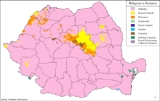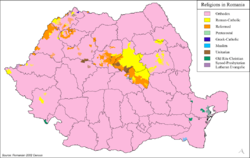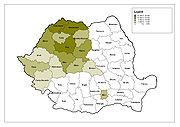
Religion in Romania
Encyclopedia

Romania
Romania is a country located at the crossroads of Central and Southeastern Europe, on the Lower Danube, within and outside the Carpathian arch, bordering on the Black Sea...
is a secular state
Secular state
A secular state is a concept of secularism, whereby a state or country purports to be officially neutral in matters of religion, supporting neither religion nor irreligion. A secular state also claims to treat all its citizens equally regardless of religion, and claims to avoid preferential...
, and it has no state religion
State religion
A state religion is a religious body or creed officially endorsed by the state...
. However, an overwhelming majority of the country's citizens are Christian
Christian
A Christian is a person who adheres to Christianity, an Abrahamic, monotheistic religion based on the life and teachings of Jesus of Nazareth as recorded in the Canonical gospels and the letters of the New Testament...
. 86.7% of the country's population identified as Eastern Orthodox
Romanian Orthodox Church
The Romanian Orthodox Church is an autocephalous Eastern Orthodox church. It is in full communion with other Eastern Orthodox churches, and is ranked seventh in order of precedence. The Primate of the church has the title of Patriarch...
in the 2002 census (see also: History of Christianity in Romania
History of Christianity in Romania
The history of Christianity in Romania began within the Roman province of Lower Moesia where many Christians suffered martyrdom at the end of the 3rd century. Nevertheless, Christian communities have been attested in several locations on the territory of modern Romania by over a hundred...
). Other Christian denominations include Roman Catholicism (4.7%), Calvinism
Calvinism
Calvinism is a Protestant theological system and an approach to the Christian life...
(3.7%), Pentecostal denominations (1.5%) and the Romanian Greek-Catholic Church (0.9%). Romania also has a small but historically significant Muslim minority, concentrated in Dobrogea, who are mostly of Crimean Tatar
Crimean Tatars
Crimean Tatars or Crimeans are a Turkic ethnic group that originally resided in Crimea. They speak the Crimean Tatar language...
and Turkish ethnicity and number 67,500 people. Based on the 2002 census data, there are also approximately 6,000 Jews
Judaism
Judaism ) is the "religion, philosophy, and way of life" of the Jewish people...
and 23,105 people who are of no religion or atheist.
Eastern Orthodoxy

Roman Catholicism
According to the 2002 census, there are 1,028,401 Roman Catholics in Romania, making up 4.7% of the population. The majority of Roman Catholics are of Hungarian ethnicity, even though there are also more than 300,000 ethnic Romanian Catholics, mainly in TransylvaniaTransylvania
Transylvania is a historical region in the central part of Romania. Bounded on the east and south by the Carpathian mountain range, historical Transylvania extended in the west to the Apuseni Mountains; however, the term sometimes encompasses not only Transylvania proper, but also the historical...
.
Greek Catholicism

Transylvania
Transylvania is a historical region in the central part of Romania. Bounded on the east and south by the Carpathian mountain range, historical Transylvania extended in the west to the Apuseni Mountains; however, the term sometimes encompasses not only Transylvania proper, but also the historical...
.
According to the information, valid for the end of 2003, given in the 2005 Annuario Pontificio
Annuario Pontificio
The Annuario Pontificio is the annual directory of the Holy See. It lists all the popes to date and all officials of the Holy See's departments...
, the Romanian Greek-Catholic Church then had 737,900 followers, many bishops, some 716 diocesan priests and 347 seminarians of its own rite. The dispute over the figure is included in the United States Department of State
United States Department of State
The United States Department of State , is the United States federal executive department responsible for international relations of the United States, equivalent to the foreign ministries of other countries...
report on religious freedom in Romania. The Romanian Orthodox Church
Romanian Orthodox Church
The Romanian Orthodox Church is an autocephalous Eastern Orthodox church. It is in full communion with other Eastern Orthodox churches, and is ranked seventh in order of precedence. The Primate of the church has the title of Patriarch...
continues to claim many of the Romanian Greek Catholic Church's properties.
Protestantism
According to 2002 census Protestants represent 6.5% of total population (1,411,274 persons). Major denominations are Reformed Church in RomaniaReformed Church in Romania
The Reformed Church in Romania is the organization of the Calvinist church in Romania. The majority of its followers are of Hungarian ethnicity and Hungarian is the main church language...
(3.2%), Pentecostals
Pentecostalism
Pentecostalism is a diverse and complex movement within Christianity that places special emphasis on a direct personal experience of God through the baptism in the Holy Spirit, has an eschatological focus, and is an experiential religion. The term Pentecostal is derived from Pentecost, the Greek...
(1.5%), Baptists (0.6%), Adventists (0.4%), Unitarians
Unitarianism
Unitarianism is a Christian theological movement, named for its understanding of God as one person, in direct contrast to Trinitarianism which defines God as three persons coexisting consubstantially as one in being....
(0.3%), Plymouth Brethrens (0.2%) and Lutherans (0.2%).
Islam

Although the number of adherents of Islam
Islam
Islam . The most common are and . : Arabic pronunciation varies regionally. The first vowel ranges from ~~. The second vowel ranges from ~~~...
is relatively small, Islam enjoys a 700 year tradition in Romania particularly in Northern Dobruja
Northern Dobruja
Northern Dobruja is the part of Dobruja within the borders of Romania. It lies between the lower Danube river and the Black Sea, bordered in south by Bulgarian Southern Dobruja.-Geography:...
, a region on the Black Sea
Black Sea
The Black Sea is bounded by Europe, Anatolia and the Caucasus and is ultimately connected to the Atlantic Ocean via the Mediterranean and the Aegean seas and various straits. The Bosphorus strait connects it to the Sea of Marmara, and the strait of the Dardanelles connects that sea to the Aegean...
coast which was part of the Ottoman Empire
Ottoman Empire
The Ottoman EmpireIt was usually referred to as the "Ottoman Empire", the "Turkish Empire", the "Ottoman Caliphate" or more commonly "Turkey" by its contemporaries...
for almost five centuries (ca. 1420-1878). According to the 2002 census, 67,566 people, approx. 0.3% of the total population, indicated that their religion was Islam. 97% of the Romanian Muslims are residents of the two counties
Counties of Romania
The 41 judeţe and the municipality of Bucharest comprise the official administrative divisions of Romania. They also represent the European Union' s NUTS-3 geocode statistical subdivision scheme of Romania.-Overview:...
forming Northern Dobruja: eighty-five percent live in Constanţa County
Constanta County
Constanța is the name of a county in the Dobruja region of Romania. Its capital city is also named Constanța.-Demographics:In 2002, it had a population of 715,151 and the population density was 101/km². The degree of urbanization is much higher than the Romanian average. In recent years the...
, and twelve percent in Tulcea County
Tulcea County
Tulcea is a county of Romania, in the historical region Dobruja, with the capital city at Tulcea.-Demographics:In 2002, Tulcea County had a population of 256,492...
.

